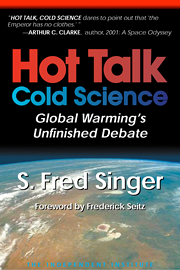Contrary to persistent claims by environmentalists, Methane is not an important greenhouse gas (GHG); it has a totally negligible impact on climate. Attempts to control methane emissions make little sense; the just-announced [Jan 14] White House plan to reduce emissions by 40 to 45% by 2025 ignores well-established ‘text-book’ science.
Methane (chemical formula CH4) is the main component of natural gas. It may technically be defined as a greenhouse gas since it absorbs strongly in some portions of the infrared spectrum; but its impact on climate is insignificant. Its atmospheric level has been increasing because about half of the methane is produced by processes related to human activities, such as cattle raising, rice agriculture, landfills, and the production of oil and natural gas; it is also released in coal mining and from leaky natural gas pipelines. The major non-human sources include swamps and bogs.
Some decades ago I predicted [Nature 1971] anthropogenic methane production and estimated values that are roughly in accord with modern ones. At that time, I was primarily interested in what happens to methane once is diffuses into the stratosphere. We found that the current human-associated production of methane was equivalent to a fleet of 500 SSTs (supersonic transport aircraft) depositing water vapor into the dry stratosphere; these estimates have since been confirmed by balloon-borne radiosondes. Many will recall that in the early 1970s, fear of ozone depletion and increase in skin cancers led to the demise of the US-SST project—although economic arguments already showed that at that time SSTs made little sense.
EPA plans to control methane emissions
The White House now plans to impose a new set of regulations on the oil and natural gas industries, targeting emissions of methane—even as emissions plummet. According to the Wall Street Journal:
“Overall emissions fell 4.7% between 1990 and 2008 and 6.3% between 2008 and 2012, the most recent year an estimate is available in the EPA’s greenhouse gas inventory. Natural gas is the source of less than a third of the total, the next largest being “enteric fermentation,” or livestock flatulence. Those, er, emissions rose 2.3% over 1990-2012.”
The basis for proposed control of methane is the usual shoddy climate science, as propagated in various UN-IPCC (Intergovernmental Panel on Climate Change) reports. These claim that the “global warming potential” of a methane molecule is about 50 times that of CO2—and that climate forcing from growth of atmospheric methane is about 20% of CO2’s. IPCC estimates are too high by as much as a factor of 100. They made two basic scientific errors, as can be readily shown [see below]. They overlooked the fact that the infrared absorption bands of atmospheric water vapor cover those of methane (as pointed out by my physicist colleague Dr. Tom Sheahen); one simply cannot absorb the same radiation twice. Further, the methane bands are located far from the peak of the surface heat emission spectrum, where there is little energy available to be absorbed. I don’t know how IPCC got their wrong numbers. In truth, getting the right numbers involves a lot of detailed work.
Details of methane impacts
While the climate effects of methane have been vastly overestimated by the IPCC, the detailed calculations are quite difficult and require inputs of radiation data from satellites.
1. The infrared absorption bands of methane, at wavelengths of roughly 3 and 8 microns, are overlain by absorption from water vapor. But once the water vapor absorbs the radiation in these bands, there is really nothing left for methane to absorb. So the estimates of methane being 20-70 times more effective per molecule than CO2 (as estimated by IPCC), or that methane forcing is 20% of CO2 forcing, as shown in various IPCC reports, makes absolutely no sense.
2. However, the effect of methane on climate may not be quite zero. Much depends on the altitude and latitude distribution of water vapor, which is highly variable. Imagine, for example, that all water vapor is concentrated near the earth’s surface and therefore absorbs the emitted infrared from the land surface and ocean. Methane, on the other hand, has a lifetime of about 8 years, long enough to be well mixed in the atmosphere. It will therefore absorb the radiation emitted from the water vapor in the ‘boundary layer’ and produce what amounts to a limited amount of climate forcing. Separately, one must also consider the complicated effects of the stratospheric water vapor created there by diffused methane.
Clearly, we should look at the radiation emitted into space in the appropriate infrared bands to see if there’s any trace of methane absorption. For this purpose one can use data from the AIRS satellite, taken at various times and locations, such as over the tropical ocean, the Sahara desert, and the East- Antarctic plateau.
3. Finally, we have to note that the emitted infrared from the surface is that of a “black body” with a temperature peak near 15 microns. This means that the actual energy contained in the methane absorption bands is quite small, although not completely negligible. But it certainly does not amount to 20%, as claimed by the IPCC.
Little need for methane control
So there are good reasons to doubt that methane, although (technically) a greenhouse gas, has important climate consequences. This will come as a bitter disappointment to environmental organizations that have been revving up to impose emission controls on methane, once they have imposed controls on CO2. It would mean the end to all sorts of nonsensical schemes, such as controlling the diet of cows.
On the other hand, the anthropogenic increase of methane does lead to an increase in stratospheric water vapor. Although slight, it may have possible, minute climate effects. But more important is its effect on stratospheric ozone; this is something that should be considered by the Montreal Protocol and all those who worry about ozone depletion. Note, however, that according to UN reports there has been no evidence for any stratospheric depletion since 1993.
Conclusion
According to the WSJ editorial, from 2008-2012 the “U.S. became the world’s natural-gas leader, with production increasing by nearly fourfold since 2008. The U.S. added 600,000 miles of gas pipeline, a 30% increase, utilities substituted gas for coal on a massive scale, and the economy grew. Methane emissions nonetheless fell.”
The editorial goes on to suggest:
“The real reason methane has become an obsession of the green lobby is that it sometimes leaks when extracting or transporting oil and especially natural gas. Thus methane [control] can be a pretext for interfering with and raising the costs of drilling.”
So in addition to a simple ’power-grab’ that expands EPA’s regulatory reach, we have here an attempt to cripple the one bright spot of US energy production. Just who are these EPA folks working for – and where is their science?









